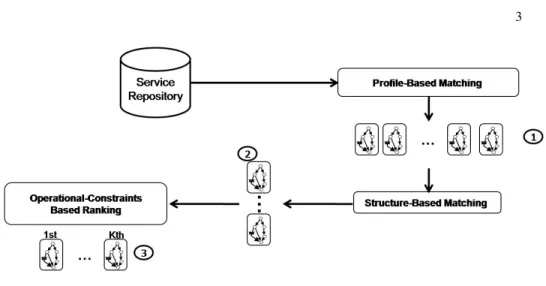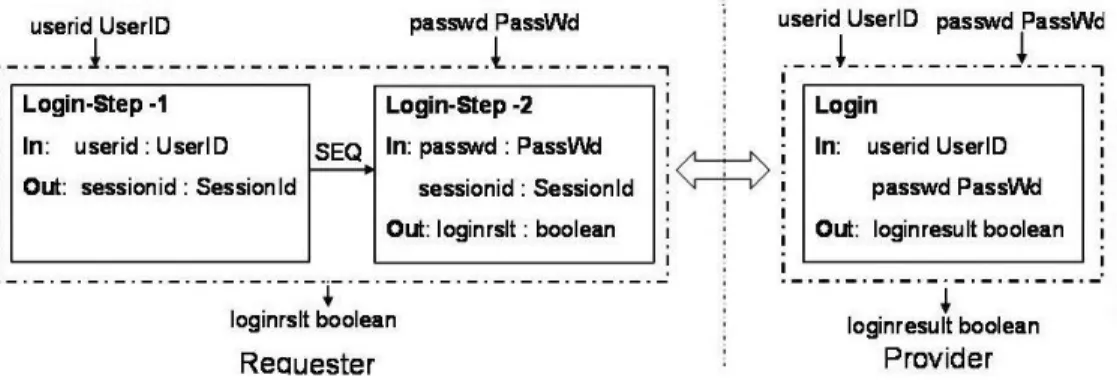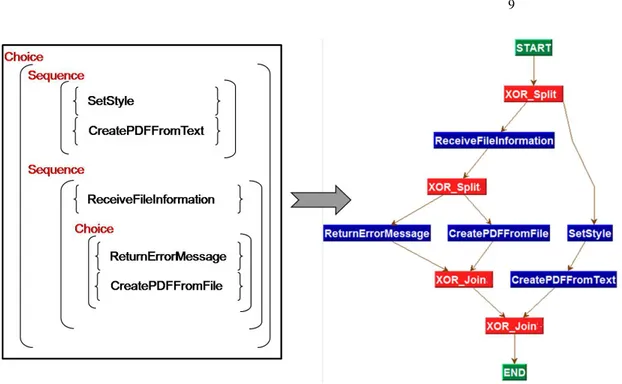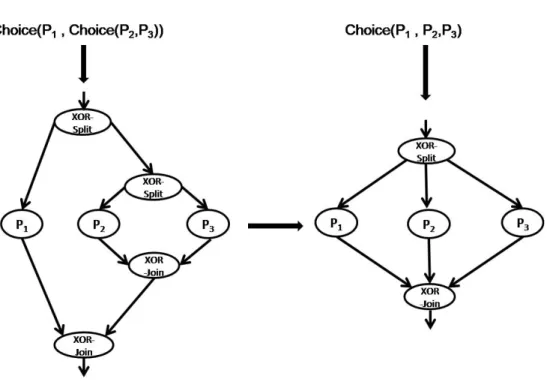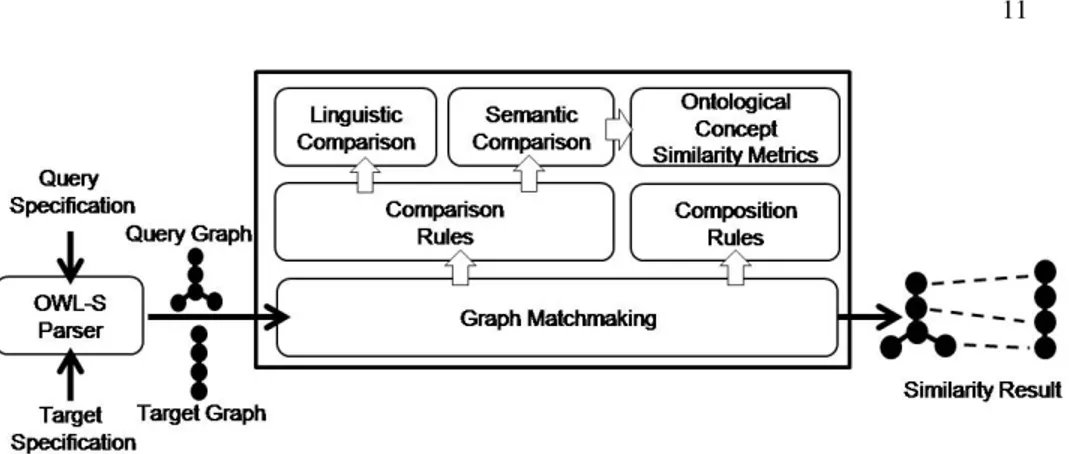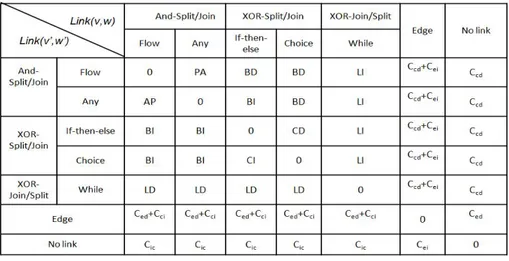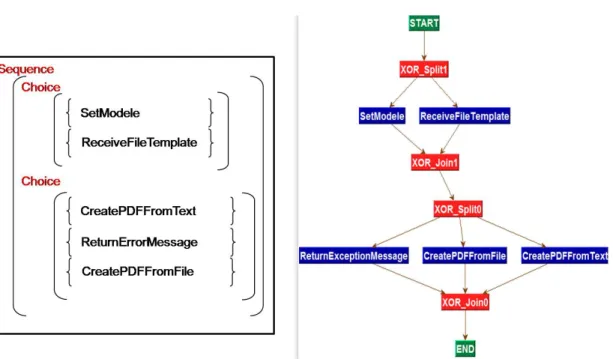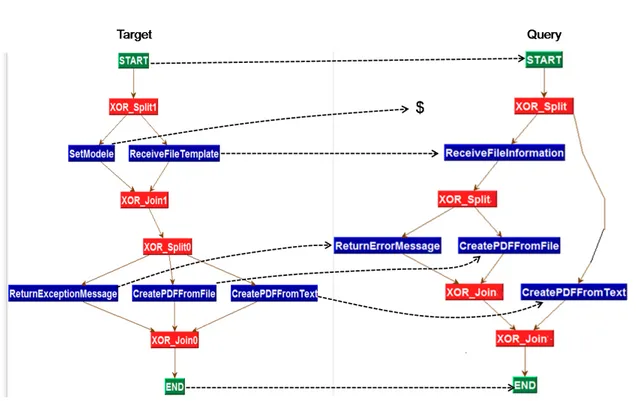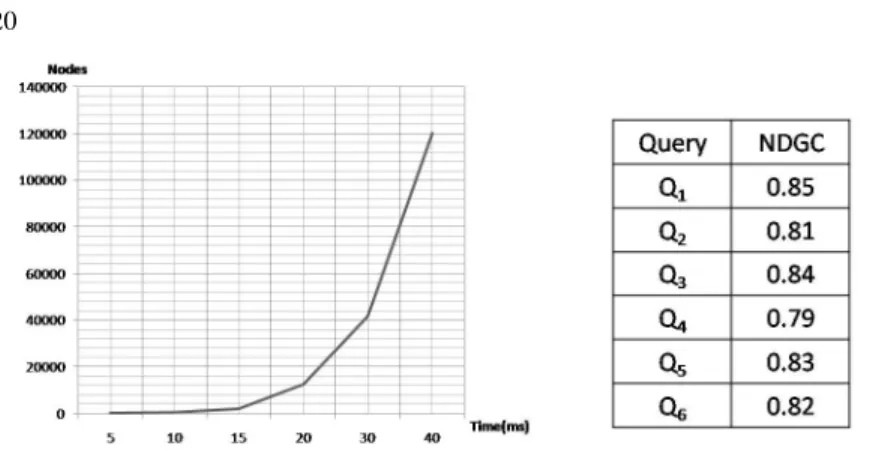Ahmed Gater, Daniela Grigori, Mokrane Bouzeghoub
Prism, Universite de Versailles Saint-Quentin en Yvelines 45 avenue des Etats-Unis, 78035 Versailles Cedex, FRANCE
Abstract. One of the key tasks in the service oriented architecture that seman-tic web services aim to automate is the discovery of services that can fulfill the application or user needs. OWL-S is one of the proposals for describing seman-tic metadata about web services, which is based on the OWL ontology language. The OWL-S ontology is organized in three modules: the Service Profile module describes the functionality of the service; the Process Model module describes how it does it; and the Service Grounding module describes how to access the service.
Majority of current approaches for matching OWL-S processes take into account only the input/output service profile. In this paper we argue that, in many situa-tions, the service matchmaking should take into account also the process model. When searching services for integrating in a given application, the process model specifying how to interact with the provider has to be taken into account in the discovery process. Other application example is scientific workflow discovery, where scientists look in a workflow repository for existing workflows that could support their research. We propose to develop matching techniques that operate on OWL-S process models and allow to retrieve in a given repository, the pro-cesses most similar to the request. To do so, we reduce the problem of process matching to a graph matching problem and we adapt existing algorithms for this purpose. We propose a similarity measure that will be used to rank the discovered services. This measure captures differences in process structure and semantic dif-ferences between input/outputs used in the process.
Keywords: OWL-S processes, web services, process matching
1
Introduction
Semantic web services envision a greater access to services on the web and a more au-tomatic support to their management by providing the ability to describe their seman-tics in a formal and machine-processable manner. One of the key tasks in the service oriented architecture that semantic web services aim to automate is the discovery of services that can fulfill the application or user needs.
Majority of new approaches for semantic web services discovery are based on for-mal descriptions of both service advertisements, i.e. the description that the service provider publishes in a registry, and requests, i.e. the description that a user is looking for. These descriptions are written in the same description language (such as, for exam-ple, OWL-S [1]) and defined in an underlying decidable description logic based ontol-ogy language such as OWL-DL, or OWL-Lite. This way, description logic reasoning can be used to automatically determine services that semantically match with a given
service request based on the terminological concept subsumption relations computed in the underlying ontology. Examples of such logic-based approaches to semantic service matchmaking are the OWL-S UDDI matchmaker [2] and WSMO discovery approach [3].
OWL-S [1] is one of the proposals for describing semantic metadata about web ser-vices, which is based on the OWL ontology language. OWL-S covers three main parts: the service profile for advertising and discovering of services; the process model, which gives a detailed description of a service’s actions and behaviour; and the grounding, which provides details on how to cooperate with a service.
Current approaches for matching OWL-S processes take into account only the ser-vice profile, by exploiting the relation between inputs and outputs concepts in the on-tology ([4]). As we will see in next section, discovering services using only their in-puts/outputs is not sufficient for some applications (service integration, scientific work-flwo discovery, etc.).
In our vision, web service discovery can be formulated as a three-phases process (see figure 1):
– Phase 1: profile-based matching which uses information retrieval techniques, pos-sibly improved by ontological knowledge, to select the first bunch of services based on key-words and vectorial model matching,
– Phase 2: structure-based matching which exploits behavioral properties given in the business process specification; usually leading to graph matching or automata matching,
– Phase 3: operational-constraints based ranking of the results provided by the previ-ous phase.
Our work, is concerned by phase 2. We assume the user request defined as a process model similarly to the target services specified in OWL-S and published in a standard registry.
In this technical report, we propose to develop matching techniques that operate on OWL-S process models and allow to retrieve in a given repository, the processes most similar to the request. To do so, we reduce the problem of process matching to a graph matching problem and we adapt existing algorithms for this purpose. We propose a sim-ilarity measure that will be used to rank the discovered services. This measure captures differences in process structure and semantic differences between inputs/outputs that defines atomic processes.
In the next section we present several motivating scenarios. Section 3 presents ex-isting approaches for service retrieval and shows their drawbacks for the presented sce-narios. In section 4 we show how the process model matching is reduced to a graph matching problem. Section 5 shows how the graph matching algorithm can be used for OWL-S process matchmaking. In section 6 we present the prototype implementation and an experimental study of the matchmaking algorithm. Finally section 7 presents ongoing work and conclusions.
Fig. 1. Web service discovery steps
2
Motivating scenarios
In this section we present two scenarios requiring process matchmaking. The first exam-ple situates in the context of web services integration and consists in retrieving services having compatible process models. The second application is scientific workflow dis-covery, where a user look in a workflow repository for existing workflows that could support their research. The goal is to reuse the workflow or workflow fragment by cus-tomizing it with different parameters settings or adapt it, by making small changes to its structure to fit his new purpose.
Web services integration Consider a company that uses service S to order office suppli-ers. Suppose that the company wants to replace its current partner or to find a new re-tailer (say WalMart or Target). Many existing services are programmed to exchange data according to a specified protocol. The allowed message exchange sequences are called business protocols and can be expressed for example using BPEL abstract processes, or OWL-S (for process models consisting of semantically annotated web services). Thus the company will search for a service having a business protocol that is compatible with service’s business protocol. Among retailer services, the most compatible one has to be found. If the service is not fully compatible, the company will adapt its service or will develop an adaptor in order to interact with the retrieved service. In both situations, the differences between the business protocols have to be automatically identified. In the former case, finding the most similar service allows to minimize the development cost. In the latter case, identifying automatically the differences between protocols is the first stage in the process of semi-automatically developing adapters (see [5]). An approach was proposed in [6] for mediating two OWL-S process models (provider and requester). But, complementary to this approach, given a requestor service model, a method is re-quired allowing to find in a repository of OWL-S processes, a provider service which has the same process model or, if such a service does not exist, the most similar one.
Retrieving scientific workflows Collaboratories emerge on the web, allowing scientists to share and re-use the scientific workflows describing their experiments. As an exam-ple, myExperiment (www.myexperiement.org) is one of the current public workflow repositories containing more than 150 distinct scientific workflows since Sept. 2008, contributed by 751 users. While current retrieval facilities in workflow repositories are mostly limited at browsing and keywords based searches, recent works [7, 8] elicited requirements for workflow discovery through an experiment with scientists and devel-opers form the myGrid workflow environment. The experiments showed: (i) the will-ingness of users to share and reuse workflows, (ii) the limits of current retrieval facilities and (iii) that process based discovery is a required feature. As some of these repositories use ontologies to describe and discover services (see [9] as an example in a bioinformat-ics setting), they require methods and tools to retrieve semantic based process models based on the underlying process description.
Thus, the technical challenges for defining a process based discovery method for this kind of applications are the following:
– identifying similar activities in two processes by using all sources of evidence: their names, their inputs and outputs,
– defining a similarity measure taking into account structural differences (sequencing order differences),
– taking into account granularity differencies: the same functionality can be imple-mented by a developper as an activity, while other developer could decompose it in several activities. The figure 2 shows such an example for implementing a user con-nection. The left hand side shows a process ”Requester” composed of a sequence of two atomic processes: Login-Step-1 and Login-Step-2. Both processes do not match with the process ”Provider” (the right hand side of the figure 2). But the composition of the ”Login-Step-1” and ”Login-2-Step” processes gives rise to a process similar to the ”Provider”.
3
Related work
Currently, the algorithms for Web services discovery in registers like UDDI or ebXML are based on a search by key words or tables of correspondence of couples (key-value). Within the framework of the semantic Web, description logics were proposed for a richer and precise formal description of services. These languages allow the definition of ontologies, such as for example OWL-S, which are used as a basis for semantic matching between a declarative description of the required service and descriptions of the services offered ([10–12]). In [10, 12], a published service is matched with a re-quired service when the inputs and outputs of the rere-quired service match the inputs and outputs of the published service (i.e., they have the same type or one is a generalization of the other). In [2], several filters are defined for service retrieval: the name space, the domain of ontology that is used, types of inputs/outputs and constraints. In [4], authors define OWLS-MX matchmaker that extends the last approach by introducing approx-imate matching based on IR similarity metrics. The approach presented in [13] takes into account the operational properties like execution time, cost and reliability. The authors of [14] provide a lightweight semantic comparison of interfaces based on simi-larity assement methods (lexical, attribute, interface and QoS simisimi-larity). Recently, the World Wide Web Consortium (W3C) produced a standard set of Semantic Annotations for WSDL (SAWSDL) [15], aiming at disambiguating the semantic of Web services description during discovery.
Service retrieval based on key words or some semantic attributes is not satisfactory for a great number of applications. The tendency of recent works is to exploit more and more knowledge on service components and process model. The need to take into account the process model of the service described by a process model was underlined by several researchers [16, 11, 17, 18].
In [11], in order to improve precision of web service discovery, the process model is used to capture the salient process model of a service. A query language for services is defined which allows to find services by specifying conditions on the activities which compose them, the exceptions treated, the flow of the data between the activities.
In [16], authors argue that the matchmaking based on service input and output is not sufficient as some output data may be produced only under certain internal condi-tions. Thus, they propose an algorithm that matches output data taking into account the process structure, for instance conditional branching.
Different approaches have been proposed for checking process compatibility. These approaches use different formalisms (automata [18], Petri Net [19], pi-calculus [20]) and the underlying theory support to formally define process equivalence.
BP-QL [21] is a graph-based language for querying BPEL processes which allows to navigate along the path-dimension inside a single process graph and to zoom across process graphs of the used services. This approach does not allow to retrieve patterns similar to the query, i.e. if a graph containing the query pattern does not exist, but a graph containing a similar one exist, it will not be returned to the user.
BPMN-Q is another query language for processes expressed using Business Process Modeling Notation (BPMN). Semantic expansion of BPMN-Q queries is realized by constructing new queries using similar activities to the ones employed in the query and returning results that match either the original query or any of its derivatives [22].
A new process model for web services is presented in [23] which associates mes-sages exchanged between participants with activities performed within the service. Ac-tivity profiles are described using OWL-S (Web Services Ontology Language). Web services are modelled like non-deterministic finite automatons. A new query language is developed that expresses temporal and semantic properties on services process mod-els. The choice of finite state automata as a modelling formalism limits the expressive-ness of the models, for instance representing parallel execution capabilities can lead to very large models.
Complementary to the work presented in this paper are recent works that try to uncover the particular metrics people use for establishing workflow similarity. Bernstein and colleagues [24] look for the best semantic similarity measures to rank business processes from the MIT Process Handbook, based on a process ontology. The work of Wombacher [25] seeks to elicit the similarity metrics used by workflow researchers when comparing the control flow of workflows described by Finite State Machines (FSMs). Both works show that a general similarity measure reflecting human similarity assessments can hardly be found, the first one suggesting to personalize the similarity measures to the user’s similarity assessment style.
To summarize, the need to take into account the service process model in the re-trieval process was underlined by several authors and some very recent proposals exist ([23],[18]). Bu these exact matchmaking approaches, give a negative answer to the user if a model satisfying exactly his requirements does not exist in the registries, even if a model that requires a small modification exists. To overcome this limit, [26] proposes an approach for service retrieval based on process model specification allowing an ap-proximate match. In this paper we extend this work for semantic annotated processes. To the best of our knowledge, there is not another approach allowing to retrieve OWL-S processes having similar process models.
4
A graph-based approach for process model matchmaking
In this section we show how the process matching is reduced to a graph matching prob-lem. We are interested in retrieving process models that have similar structure if models that have identical structure do not exist. To do so, process models are transformed to graphs, as graphs are a general and powerful data structure that have been successfully applied in different applications for assessing objects similarity.
In the remainder of this section we recall briefly the OWL-S process model and we show how it is transformed to a process graph. Section 4.2 recall the principles of the graph matching method that we use, the error correcting subgraph isomorphism.
OWL-S[1] is an ontology of services that enables greater access to web services by offering a set of markup language constructs for describing the properties and capabili-ties of Web services in unambiguous, computer-intepretable form. OWL-S covers three main parts: the service profile for advertising and discovering of services; the process model, which gives a detailed description of a service’s actions and behaviour; and the grounding, which provides details on how to cooperate with a service. The elementary unit of the process model is an atomic process, which represents one indivisible op-eration that the client can perform by sending a particular message to the service and
receiving a corresponding response. Processes are specified by means of their inputs, outputs, preconditions, and effects (IOPEs). Types of inputs and outputs are defined as concepts in some ontology or as simple XSD data-types. Processes can be combined into composite processes by using the following control constructs: sequences, any-order, choice, if-then-else, split, split-join, repeat-until and repeat-while. OWL-S offers also mechanisms for specifying data flow and parameters binding. In our case; we con-sider only the control flow (the order of operations). For this reason, we transform an OWL-S process to a process graph whose nodes are the OWL-S operations and arcs represent the order constraints between them.
4.1 Transforming OWL-S to graph
An OWL-S process model is transformed into a process graph. A process graph has at least one start node and can have multiple end nodes. The graph has two kinds of nodes: regular nodes representing the atomic activities and connectors representing split and join rules of types XOR or AND. Nodes are connected via arcs which may have an optional guard (boolean condition).
To transform an OWL-S process model to a process graph, we implemented an algorithm similar to the flattening strategy algorithm presented in [27]. The general idea is to map structured activities to respective process graph fragments. The algorithm traverses the nested structure of OWL-S control flow in a top-down manner and applies recursively a transformation procedure specific to each type of structured activity. OWL-S atomic processesare transformed to activity nodes having the following attributes: Process name (Pn), Input Set (InputSet) and Output Set (OutputSet). Connector nodes have two attributes: connector type or CT (AND-Split, AND-Join, Split, XOR-Join) and connector source or CS that records the control structure captured by the node. The sequence is transformed by connecting all nested processes with arcs. The graph representations of if-then-else and Choice consist of a block of alternative branches between an XOR split and an XOR join. The branching conditions are associated to edges in case of if-then-else. For the Repeat-Until and Repeat-While controls, a loop is created between an XOR join and an XOR split. The Split-Join is transformed to a block of parallel branches starting with an AND split and synchronized with an AND join. The any-order is abstracted to a block of branches starting with an AND split (with CS=“Any-Order”) and synchronized with an AND join (with CS=“Any-Order”). The figure 3 shows the correspondence between OWL-S constructs and graph elements. The left part of figure 4 shows an example of an OWL-S process model that allows to create a PDF file from either a text or a file. The right part shows its transformation to an OWL-S graph.
After obtaining the processs graph, some graph simplification rules are applied. These are required because equivalent process models can be specified using different syntax. For instance, one process defiens a Choice between P1 and a choice(P2,P3) while the other defines a Choice(P1,P2,P3). Thus, to improve the matching accuracy, they must be transformed to the same structures (see figure 5). In the following, we give the transformations applied for the case when two connector nodes having the same type (for instance, choice) are adjacent:
– Choice(P1,Choice(P2,P3)) −→ Choice(P1,P2,P3)
– Split-Join(P1,Split-Join(P2,P3)) −→ Split-Join(P1,P2,P3)
– Any-Order(P1,Any-Order(P2,P3)) −→ Any-Order(P1,P2,P3)
– If Cond1( If Cond2(P1) Else (P2)) Else P3−→ If ( (Cond1and Cond2) (P1))
Else ((If (Cond1and N otCond2) (P2)) Else (If (N otCond1) (P3)) )
These equivalence rules are implemented within the parser.
Fig. 3. Correspondences between OWL-S elements and graph elements
4.2 A similarity measure for graphs
By representing both user requirements (query) and provided process models (targets) as graphs, the process matching turns into a graph matching problem which can be formulated as a search for graph or subgraph isomorphism. However, it is possible that there does not exist a target process such that an exact graph or subgraph isomorphism can be found.
The error-correcting graph isomorphism integrates the concept of error correction (or inexact matching) into the matching process ([28]), by suing graph edit operations (similar to string edit distance). In the following we give the definitions of error correct-ing graph matchcorrect-ing as given in [29].
A directed labelled graph is defined by a quadruple G = (V, E, α, β) where V is the set of vertices, E ⊂ V × V is the set of edges, α : V → LV is the vertex labelling
function and β : E → LEis the edge labelling function. Given a graph G, a graph edit
operation δ on G is any of the following: substituting the label α(v) of vertex v by l, substituting the label β(e) of edge e by l0, deleting the vertex v from G, deleting the edge e from G, inserting an edge between two existing vertices, decomposing a vertex v into two vertices v1, v2, joining two vertices v1, v2into a vertex v.
Fig. 4. Transformation example of OWL-S process to graph
Definition 1. Edited graph Given a graph and a sequence of edit operations ∆ = (δ1, δ2, · · · δk), the edited graph ∆(G) is ∆(G) = δk(· · · δ2(δ1(G)))..).
Definition 2. Ec-subgraph isomorphism Given two graphs G and G0, an error cor-recting (ec) subgraph isomorphismf from G to G0is a 2-tuplef = (∆, f∆) where ∆
is a sequence of edit operations andf∆is a subgraph isomorphism from∆(G) to G0.
For each edit operation δ, a certain cost is assigned C(δ). The cost of an ec-subgraph isomorphism f = (∆, f∆) is the cost of the edit operations ∆, i.e., C(∆) =P
k
i=1C(δi).
The subgraph edit distance is then defined to be the minimum cost taken over all sequences of edit operations that are necessary to obtain a subgraph isomorphism.
5
OWL-S processes matchmaking
. In this section we illustrate the use of the error-correcting graph matching algorithm for OWL-S processes matchmaking. We first give an overview of the matchmaking process and then we discuss each step in detail.
Our OWL-S matchmaking approach, illustrated in Figure 6 is composed of the fol-lowing steps. First, the OWL-S processes to be compared are transformed to graphs.
Next, the similarity between the two graphs is evaluated by a similarity analyzer that is is composed of the following modules (Figure 6):
Fig. 5. Example of equivalence behavior transformations
– Graph matchmaking, that takes as inputs the graphs produced by the OWL-S parser and finds out the error correcting sub-graph isomorphism with minimal cost. – Comparison rules module, that groups the cost functions for the graph edit
opera-tions.
– Composition module, that checks whether composition/decomposition operations are necessary and add their cost to the total distance.
– Semantic comparison, that calculates the semantic similarity between the Input/Output concepts.
– Ontological concepts similarity metrics that contains different functions for mea-suring the degree of similarity of two concepts.
– Linguistic comparison, that implements different algorithms to find the similarity between two strings like tokenization, NGram, Check synonym, Check abbrevia-tion.
In the next sections we present in detail the functionalities of these modules.
5.1 Graph matchmaking
This module implements the algorithm for error-correcting sub-graph isomorphism de-tection ([29]). The sub-graph isomorphism dede-tection is based on a state-space searching using an algorithm similar to A* [28]. The basic idea of a state-space search is to have
Fig. 6. Process matchmaking approach
states representing partial solutions of the given problem and to define transitions from one state to another, thus, the latter state represents a more complete solution than the previous state. For each state s there is an evaluation function f (s) which describes the quality of the represented solution. In the case of sub-graph isomorphism detection, given a target graph GTand an query graph GQ, a state s in the search space represents
a partial mapping from GT to GQ.
Each partial mapping (P) implies a number of edit operations (δ1..δi) and their cost
(C(P)) is used to define the evaluation function f (s). In other words, the algorithm starts by mapping the first activity node (AN) of GT with all the AN of GQ(W ) ∪ {$}
(symbol $ is used to denote missing vertices in the target graph GT(W )) with respect
to a pruning function feasible (line 1, described in section 5.2) and chooses the best mapping (with minimal cost)(Algorithm1, line 4). This represents a partial mapping that will be extended by adding one node at a time (line 7). The process terminates when either a state representing an optimal ec-subgraph isomorphism from GT to GQ
has been reached or all states in the search space have edit costs that exceed a given acceptance threshold.
The cost of the mapping C(P0) (line 7.2) represents the cost of extending the current mapping P with the next AN in the model graph. Extending the mapping by mapping an AN v (in the query graph that is not yet mapped) to an AN w in the target graph (that does not belong to the current mapping) implies AN edit operation and edge/connector edit operations. First, the attributes of v must be substituted by attributes of w, and secondly, for each mapping (v0, w0) ∈ P it must be ensured that any link (two AN can be connected either by an edge or via a control node) between v0 and v in the query graph can be mapped to a link between w0and w in the model graph by means of edge and connector edit operations.
Since connector nodes express control flow constraints, they are compared in a man-ner similar to edges. Thus, when matching two graphs, we are not interested in finding all the correspondences between similar connector nodes, but comparing how mapped AN are connected. Section 5.2 gives more details about the cost of editing connectors.
Algorithm 1 Error-correcting sub-graph isomorphism detection (GT(V ), GQ(W )) 1: Initialize OPEN : Map the first AN v1of V onto each AN w in W ∪ {$}
IF f easible(v1, w) THEN
[1.1:]Create a mapping P = {(v1, w)};
[1.2:]Calculate the cost of this mapping C(P). [1.3:]Add P to OPEN.
2: IF No Satisfactory Matcher for v1try CompositionNodes
3: IF OPEN is empty THEN Exit.
4: Select P of OPEN such that C(P) is minimal and remove P from OPEN
5: IF P represents a complete mapping from GTto GQTHEN output P. Set accept threshold =
C(P). Goto 3.
6: Let P be the current mapping that maps k nodes from GT.
7: Extending P to P’ by mapping vk+1((k + 1)thAN of V):
FOR each AN w in W ∪ {$} that is not yet mapped to a corresponding node in V IF f easible(vk+1, w) THEN
[7.1:]P0= P ∪ {(vk+1, w)}.
[7.2:] Calculate the cost of this mapping C(P’).
[7.3:] IF C(P’)<= Accept threshold THEN OP EN = OP EN ∪ {P0}; 8: IF No Satisfactory Matcher for vk+1try CompositionNodes
9: Goto 3
5.2 Comparison rules
The Comparison rules module contains all the application-dependent functions allow-ing to calculate the cost of graph edit operations. These functions are used by the graph matching module for calculating the distance between two graphs. In the following we explain the cost functions used for OWL-S process model matchmaking. The cost for inserting, suppressing edges and vertices can be set to a constant. The cost for editing vertices (AN and connectors) are presented below.
Algorithm 2 Function AtomicProcessMatch
INPUTS: (N odei,N odej) OUTPUT:(M atchingDegree, DistanceN ode)
N odei:Struct(P ns, InputSets, OutputSets),
N odej:Struct (P nr, InputSetr, OutputSetr)
LOCAL InSimilarity, OutSimilarity: Struct(MD,SS)
Calculate Name Similarity N ameSimilarity = LS(P ns, P nr)
Calculate Input/Output Similarity
InSimilarity = SC(InputSetr, InputSets)
OutSimilarity = SC(OutputSets, OutputSetr)
IOSimilarity =InSimilarity.SS+OutSimilarity.SS2 DegreeMatch = min (InSimilarity.MD , OutSimilarity.MD) Calculate Distance Node
DistanceN ode = 1 −ωio∗IOSimilarity+ωname∗N ameSimilarity
ωio+ωname
Matching Activity Nodes The similarity of two activity nodes (OWL-S atomic pro-cesses) is computed by the function AtomicProcessMatch (see algorithm 2) by com-bining multiple sources of evidence: their names and their set of inputs and outputs. Activity names are human-assigned ; they can be formed by a combination of words and can contain abbreviations. Thus, activity names similarity (LS) is computed by the module Linguistic Comparison( 5.3) by using text similarity techniques. Then, the sim-ilarity of the input and output sets is computed. Since the types of inputs and outputs are concepts in some ontology, we use semantic comparison module (function SC in algorithm 2) to compare them. SC function returns the similarity between the two con-cepts (SS, for semantic similarity) and the semantic relationship between concets in the ontology (MD for Matching Degree, for example plugin).
Finally, the distance between the two activities (DistanceNode) is calculated by the difference between 1 and the the weighted average of inputs/outputs semantic similarity and names similarity. (Weights ωio and ωname indicate the contribution of semantic
similarity of Input/Output and name similarity respectively, 0 ≤ ωname ≤ 1 and 0 ≤
ωio ≤ 1). The function returns also the minimum between the two Input/Output sets
matching degrees (DegreeMatch, for example plugin).
Fig. 7. ConnectorEditingCost table
Matching connector nodes As mentionned above, the connector nodes define the se-quencing constraints between process steps. Thus, we are not interested in finding all the correspondences between similar connector nodes, but comparing how mapped ac-tivities are linked (by edge or via a connector node). Suppose that the current mapping p is extended by mapping v to w (v ∈ G and w ∈ GI). Thus, for each mapping
(v0, w0) ∈ p (v0 ∈ G and w0 ∈ G
I) such that there is a link (link1) between v and v0
an edit operation is needed or not. linkican be an edge or a connector node. Figure 7
shows all cases that may be encountered when computing the cost of editing connector nodes. Parameters of this table are applications-dependent offering more flexibility in adapting the algorithm for different applications.
Pruning the state-space search To reduce the number of generated mappings, we define a pruning function: feasible. If the distance between two activity nodes exceeds a certain threshold (N odeT hreshold.DistanceN ode), the research space is pruned (not extended). Moreover, user can specify the minimal semantical relationship degree that inputs/outputs of found activities should have with the requested ones
(N odeT hreshold.M atchingDegree). Algorithm 3 shows the pruning function.
Algorithm 3 Function feasible
INPUTS: v,w, N odeT hreshold OUTPUT: BOOL N odeT hreshold : Struct(MatchingDegree, DistanceNode) return
( w=$ (/*deleting a node is always feasible*/) or
(AtomicProcessMatch(v,w).DegreeMatch >= NodeThreshold.DegreeMatch and AtomicProcessMatch(v,w).DistanceNode <= NodeThreshold.DistanceNode))
5.3 Semantic comparison
The Semantic comparison module (function SC in the algorithm 2) compares two Input or two Output sets taken in the same ontology. When comparing two inputs or outputs, four matching degrees (MD) can be defined according to the semantic relationships between concepts. Thus, the similarity between concepts is assessed using a pair of parameters, matching degree (MD) and semantic similarity (SS) (see Algorithm 4).
Algorithm 4 Function ConceptSimilarity
INPUTS : Cr,Cs OUTPUT:Sim : Struct(SS,MD)
IF (Cr .
= Cs) THEN
Sim.SS = 1 ; Sim.MD = Exact ELSE IF Cs
.
≥ CrTHEN
Sim.SS = 1 ; Sim.MD = Plug-In ELSE IF Cr
.
≥ CsTHEN
Sim.SS = OntologySim(Cr, Cs) ; Sim.MD = Subsumes
ELSE
Sim.SS = OntologySim(Cr, Cs) ; Sim.MD = Fail
In the first case, which is trivial, if two concepts are equal then their similarity is 1. In the second case, the similarity is 1 since Cr has at least the same properties as Cs
(Cris a specialisation of Cs). (Service S requires less input than it has been specified in
the request R. ; this guarantees that S will be executable with the provided input). In the third and forth cases, we use OntologySim function to compute concept similarities. Thus, depending on the ontology and the targeted applications, different metrics can be used; these are grouped in the Ontological Concept Similarity metrics module. Two main approaches have been proposed in the literature for computing concepts similarity: the similarity is related to the path length between concepts, or is based on both common and different characteristics. In our tests, we used the metric (1) belonging to the first approach:
OntologySim(Cr, Cs) = 1 − [2 ∗ ω(ccp(Cr, Cs)) − ω(Cr) − ω(Cs)] (1);
where ccp(Cr, Cs) is the closest common parent of Crand Csand ω(c) is the weight
of concept in the ontology.
Function ConceptSimilarity is the basic block to calculate the similarity between two sets of concepts that is done by MatchSet function. MatchSet calculates the best matching between two sets (Dr, Ds) of concepts that maximizes the total of semantic
similarities (SS). The formula of MatchSet is given bellow :
M atchSet(Dr, Ds).SS = M ax(M atchSet.SS(Dr− I, Ds− J )+ ConceptSimilarity(I, J ).SS), if Dr6= φ, Ds6= φ, I ∈ Dr, J ∈ Ds 0, if Dr= φ ∨ Ds= φ
MatchSet function returns also the set MDSet of mapped pairs (I, J ). This brings us to the definition of semantic comparison between two sets of concepts. The seman-tic similarity and the matching degree between two sets of concepts are, respectively, the average of semantic similarities and the minimum of matching degrees of all the concept-matched pairs within MDSet (knowing that MD are ordered according to their restriction : EXACT > PLUG-IN > SUBSUMES > Fail):
SC(Dr, Ds).SS =
M atchSet(Dr,Ds).SS min(|Dr|,|Ds|)
SC(Dr, Ds).M D= min
(I,J )∈M Dset(ConceptSimilarity(I, J ).M D);
Linguistic comparison The Linguistic comparison module calculates the linguistic sim-ilarity between two labels based on their names [30]. The labels are often formed by a combination of words and can contain abbreviations. To obtain a linguistic distance between two strings, we use existing algorithms: tokenization, NGram [31], Check syn-onym(that uses a linguistic dictionary, e.g. Wordnet [32] in our implementation) , Check abbreviation(that uses a custom abbreviation dictionary), etc.
The NGram algorithm estimates the similarity according to a number of common qgrams between labels names [31]. The Check synonym algorithm uses a linguistic dictionary (e.g. Wordnet [32] in our implementation) to find synonyms while Check abbreviationuses a custom abbreviation dictionary. If all algorithms return 1, there is an exact matching. On the other hand, if all the algorithms return 0, it means that there is no matching between labels. If the NGram value and the Check abbreviation value
are equal to 0, and Check Synonym is between 0 and 1, the total linguistic similarity value will be equal to the Check Synonym one. Finally, if the three algorithms values are between 0 and 1, the similarity LS ([30]) is the average of them:
LS = (1 if (m1 = 1 ∨ m2 = 1 ∨ m3 = 1) m2 if (0 < m2 < 1 ∧ m1 = m3 = 0) 0 if (m1 = m2 = m3 = 0) m1+m2+m3 3 if m1, m2, m3 ∈ (0, 1)
where, m1 = Sim(NGram), m2=Sim(Synonim Matching) and m3= Sim(Abbreviation Expansion).
5.4 Composing activity nodes
Due to the fact that query and target graphs may be specified at different granularity lev-els, the composition is done to bring them at the same granularity level. For instance, an activity in the query graph may be specified by several synchronised activities in the target graph. Figure 2 shows an example of such situation.
The current mapping P is extended by mapping a new activity node v(P nv, InputSetv, OutputSetv) ∈
GT against all remainig nodes wi in GQ (nodes that are not mapped yet is denoted
T0). Suppose that no satisfactory matcher is found for v (∀wi ∈ T0, cost(v, wi) >
threshold). We then try to find satisfactory matcher by composing nodes in T0.
The composition is done recursively by adding one node at a time. First, the first two nodes of T0are composed, then it recursively composes the result node of the previous iteration with an other node in T0, and so on until one of the composition conditions is not satisfied. The activity node v is then mapped to the last composition result node.
Given two nodes w1(P n1, InputSet1, OutputSet1) and w2(P n2, InputSet2, OutputSet2)
that are in T0, the composition is permitted when : 1. Condition 1:w1and w2are in parallel or sequence.
2. Condition 2:v and w1have in common one input attribute or one output attribute
at least. Similarly for v and w2:
– (InputSet1∩ InputSetv) ∪ (OutputSet1∩ OutputSetv),
– (InputSet2∩ InputSetv) ∪ (OutputSet2∩ OutputSetv),
3. Condition 3:The cost of the composition of the (I + 1)thiteration is less than the
cost of the composition of (I)thone. The cost of the first iteration is the cost of
mapping v to the first AN in T’.
w1may be a node originally belonging to T0 or the result of previous node
composi-tions. The composition routine is given by the algorithm 5. The attributes of the com-position result node w(P nw, InputSetw, OutputSetw) of two are :
– InputSetw= InputSet1∪ InputSet2− ( OutputSet1∩ InputSet2),
– OutputSetw= OutputSet1∪ OutputSet2− ( OutputSet1∩ InputSet2)
When several synchronized activities of the query graph are specified by one activ-ity in the target graph, a decomposition of this node is necessary. The same approach can be followed to define the decomposition algorithm. Clearly, the flexibility of the
Algorithm 5 Function CompositionNodes
INPUTS: (v,P ,T0,OP EN )
IF (cond3(NodesToCompose) is false)
P’ = P ∪ {(v, elementatT opof N odesT oCompose)};OP EN = OP EN ∪ {P0}; Return P ∪ (v,element at Top of NodesToCompose );
ELSE //Compose
FOR ( w ∈ N odesT oCompose)
IF ((Cond1(TopNodesToCompose,w) and Cond2(TopNodesToCompose,w)) H = NodesToCompose; Remove w and top element from H
ComposedNode = Compose(element at top of NodesToCompose,w); Add Com-posedNode to H;
CompositionNodes(v,H,P); ELSE
P0= P ∪ {(v, elementatT opof N odesT oCompose)};OP EN = OP EN ∪ {P0}; ENDIF
ENDFOR ENDIF
matchmaking procedure and the accuracy of resultes will increase significantly. How-ever, if we allow many nodes to be splited or merged, the computational complexity will go up. An important issue is the choice of a threshold that improves the accuracy of matching results while execution time still acceptable.
6
Example
Suppose that we would like to find the similarity between the PDF creator service whose process model is given in 4 and an other service whose process model is given in figure 8. The dotted lines shown in 9 represent the mappings that have been found between the two graphs. These graphs are drawn from our test data.
7
Implementation and experiments
In this section we describe the prototype that we implemented for OWL-S process model matchmaking and the experiments we did to evaluate the performance of the algorithm. We implemented a system having the architecture presented in section 5, that is part of a larger plateform for ranking process models (e.g. BPEL, WSCL, see ([33]).
Since there is a lack of a referential benchmark of OWL-S process models, we generated an experimental dataset from a public repository
(http://www.di.unipi.it/ corfini/owls/owls.html) containing 15 OWL-S process models. We derivated from each of these 15 process models (considered as query processes) 7 distorted copies (considered as target process models) using adaptative operations presented in [34]. The target process models are obtained by: (1) changing the name of query atomic process into names having the same meaning for humans,(2) changing the Inputs/Outputs of query atomic process into Inputs/Outputs having a Plug-In, Subsumes
Fig. 8. PDF creator Process Model
or Fail relationships with them, (3) removing atomic processes from query, (4) changing the execution order of query process model fragments, (5) extracting subgraphs from the query process model, (6) spliting query atomic process into two sub atomic processes, and (7) merging two query atomic processes into one atomic process.
Knowing that the theoretical complexity of the the graph matchmaking algorithm is exponential, the first experiment explored the limits of our algorithm with respect to the size of the target graphs. To do so, each query graph was compared to a set of target graphs whose size varies from 5 to 40. The figure 7 shows the variation of execution times according to the size of target graph. The results reported in this graphic represent the average execution times found for each given target graph size. Despite the expo-nential theoretical complexity, the graphic 7 shows that the matchmaking algorithm can be used, with acceptable execution time, for OWL-S process models having less than 40 atomic processes. This limit is reasonable since actual process models exceed rarely this size. As mentionned previously, our algorithm depends on several parameters. The average time execution reported in the graphic correspopnd to the scores obtained for the best possible settings of parameters (Cei= 0.5, Cci= 0.8,Ced= 0.2,Ccd= 0.6).
All tests were conducted on a laptop with a core 2 duo Intel processor, 2.27 GHz, 3 GB memory, running Windows Vista OS and SUN Java Virtual Machine version 1.6.
In the second experiment, we evaluated the effectiveness of the algorithm to rank the returned graphs according to their similarity to the query. To do this, we compared the ranking list retrieved by the algorithm with a reference ranking list (manual
evalu-Fig. 9. The mapping found
ation by an expert) using the Normalizing Discount Cumulative Gain (NDCG) metric. NDGC is widely used to mesure the relevance of multi-level ranking models [35] and its formula is: N DCGp= Z1pP
p i=1
2ranki−1
log2(i+1), where rankiis the retrieved ranking of
the ith target graph using the algorithm and Z
p is the best ranking that can be found
(manual ranking). The figure 7 shows the results of NDGC for six query graphs. These results show the effectiveness of our approach for service discovery and ranking. In-deed, the developped prototype has an average precision greater than 82%. Currently, we are conducting further experiments in order to determine the optimal matching pa-rameters that allow a good compromise between time execution and ranking precision.
8
Conclusion
In this paper we proposed a solution for retrieval of OWL-S services based on the matchmaking of the process model. First we motivated the need to take into account the process model in the discovery process. By using a graph representation formalism for the process model, we proposed to use a graph error correcting matching algorithm in order to allow an approximate matching. The matchmaking algorithm returns a simi-larity degree and a matching degree (reflecting the terminological concept subsumption relationship); it outputs also the edit operations needed to transform one process into
Fig. 10. Nodes vs Time
Fig. 11. Precision of ranking
the other. The edit script could be used in future works for proposing automatic me-diation algorithms to solve differences between two process models. We implemented a prototype and we exerimentally evaluated the performance of the matchmaking al-gorithm. An interesting future extension consists in learning matchmaking parameters starting from user preferences and rankings in order to provide personalizable similarity measures.
References
1. Martin, D., M.Burstein, Hobbs, J., Lassila, O., McDermott, D., Mcllraith, S., Narayanan, S., Paolucci, M., B. Parsia, T.P., Sirin, E., Srinivasan, N., Sycara, K.: OWL-S:Semantic Markup Language for Web Services. In: W3C Member Submission, http://www.w3.org/Submission/OWL-S. (2004)
2. Kawamura, T., De Blasio, J., Hasegawa, T., Paolucci, M., Sycara, K.: A preliminary report of a public experiment of a semantic service matchmaker combined with a uddi business registry. In: Proc. of 1st International Conference on Service Oriented Computing (ICSOC). (2003)
3. Keller, U., Lara, R., Lausen, H., Polleres, A., Fensel, D.: Automatic location of services. In: ESWC. (2005) 1–16
4. M. Klusch, B. Fries, K.S.: Automated sematic web discovery with owls-mx. In: Proceedings of the fifth international joint conference on Autonomous agents and multiagent systems. (2006)
5. Benatallah, B., Casati, F., Grigori, D., Motahari Nezhad, H.R., Toumani, F.: Developing adapters for web services integration. In: Proc. of CAISE. (2005)
6. Vaculn, R., Sycara, K.: Towards automatic mediation of owl-s process models. In: IEEE International Conference on Web Services, ICWS 2007. (2007)
7. Goderis, A., Li, P., C.Goble: Workflow discovery: the problem, a case study from e-science and a graph-based solution. In: International Conference on Web Services, ICWS ’06. (2006) 312–319
8. Goderis, A., Roure, D.D., Goble, C., Bhagat, J., Cruickshank, D., Fisher, P., Michaelides, D., Tanoh, F.: Discovering scientific workflows: The myexperiment benchmarks. In: Tech-nical Report UNSPECIFIED, School of Electronics and Computer Science, University of Southampton. (2009)
9. Wroe, C., Stevens, R., Goble, C., Roberts, A., Greenwood, M.: A suite of daml+oil ontolo-gies to describe bioinformatics web services and data. In: Intl. J. of Cooperative Information Systems. (2003) 197224
10. Paolucci, M., Kawamura, T., Payne, T.R., Sycara, K.: Semantic matching of web services capabilities. In: Proc. of First International Semantic Web Conference (ISWC). (2002) 11. Bernstein, A., Klein, M.: Towards high-precision service retrieval. In: Proc. of Int. Semantic
Web Conference (ISWC). (2002)
12. Benatallah, B., Hacid, M., Rey, C., Toumani, F.: Semantic reasoning for web services dis-covery. In: Proc. of WWW Workshop on E-Services and the Semantic Web. (2003) 13. Cardoso, J., Sheth, A.: Semantic e-workflow composition. Journal of Intelligent Information
Systems 21 (2003) 191–225
14. Wu, J., Wu, Z.: Similarity-based web service matching. In: Proc. of IEEE International Conference on Services Computing. (2005)
15. Farrell, J., Lausen, H.: Semantic annotations for wsdl and xml schema. Technical report, W3C Candidate Recommendation (2007)
16. S. Bansal, S., Vidal, J.M.: Matchmaking of web services based on the DAML-S service model. In: Proc. of Int. Joint Conference on Autonomous Agents and Multiagent Systems. (2003) 926–927
17. Zdravkovic, J., P. Johanesson, P.: Cooperation of processes through message level agreement. In: Proc. of Int. Conf. On Advanced Information Systems Engineering (CAISE). (2004) 18. Wombacher, A., Mahleko, B., Fankhauser, P., Neuhold, E.: Matchmaking for business
processes based on choreographies. In: Proc. of IEEE International Conference on e-Technology, e-Commerce and e-Service. (2004)
19. Ould, N., M’Bareck, A., Tata, S.: Bpel behavioral abstraction and matching. In: Business Process Management Workshops. (2006) 495–506
20. Kuang, L., Li, Y., Deng, S., Wu, J., Shi, W., Wu, Z.: Expressing service and query behavior using pi-calculus for matchmaking. In: Proc of the 2006 IEEE/WIC/ACM International Conference on Web Intelligence. (2006) 629–632
21. Beeri, C., Eyal, A., Kamenkovich, S., Milo, T.: Querying business processes with bp-ql. Inf. Syst. 33(6) (2008) 477–507
22. Awad, A., Polyvyanyy, A., Weske, M.: Semantic querying of business process models. In: EDOC. (2008) 85–94
23. Shen, Z., Su, J.: Web services discovery based on behavior signatures. In: Proc. of IEEE International Conference on Services Computing. (2005)
24. Bernstein, A., Kaufmann, E., Brki, C., , Klein, M.: How similar is it? towards personal-ized similarity measures in ontologies. In: 7 Internationale Tagung Wirtschaftsinformatik, February. (2005)
25. Wombacher, A.: Evaluation of technical measures for workflow similarity based on a pilot study. In: In CoopIS, Montpellier, France. (2006)
26. D. Grigori, J. C. Corrales, M.B.: Behavioral matchmaking for service retrieval: application to conversation protocols. Information Systems 33 (2008) 681–698
27. Mendling, J., Lassen, K., Zdun, U.: Transformation Strategies between Block-Oriented and Graph-Oriented Process Modelling Languages. In: F. Lehner, H. Nsekabel, P. Kleinschmidt, eds.: Multikonferenz Wirtschaftsinformatik, pages 297-312. (2006)
28. Shapiro, L.G., Haralick, R.M.: Structural descriptions and inexact matching. IEEE Trans. Pattern Anal. Mach. Intell. 3 (1981)
29. Messmer, B.: Graph Matching Algorithms and Applications. PhD thesis, University of Bern (1995)
30. Patil, A., Oundhakar, S., Sheth, A., Verna, K.: Meteor-s web service annotation framework. In: Proc. of WWW Conference. (2004)
31. Angell, R.C., Freund, G.E., Willett, P.: Automatic spelling correction using a trigram simi-larity measure. Information Processing and Management 19(4) (1983) 255–261
32. Miller, G.: Wordnet: A lexical database for english. Communications of the ACM 38(11) (1995) 39–41
33. Corrales, J.C., Grigori, D., Bouzeghoub, M., Burbano, J.E.: Bematch: a platform for match-making service behavior models. In: EDBT. (2008) 695–699
34. Weber, B., Reichert, M., RinderleMa, S.: Change patterns and change support features -enhancing flexibility in process-aware information systems. Data Knowl. Eng. 66(3) (2008) 438–466
35. J¨arvelin, K., Kek¨al¨ainen, J.: Cumulated gain-based evaluation of ir techniques. ACM Trans. Inf. Syst. 20(4) (2002) 422–446
